The following sketch of the life of Nelson Perryman is drawn mainly from his papers and notes, my own and other family members’ remembrances and from information published on this website, as well as information very kindly tracked down and provided to me by Bill Burns.
Nelson Perryman began his career in the cable industry as a consulting engineer in London in 1910. In 1915 he became Assistant Electrician and Engineer with the Central and South American Telegraph Company in Peru and, in 1918, with the same company, Traffic Manager. When Central and South American Telegraph Company became All America Cables Company in 1920, he moved to New York as Superintendent of Apparatus and Equipment and, in 1925, was appointed Assistant Vice President of the company, which position he held through to his retirement in 1950.
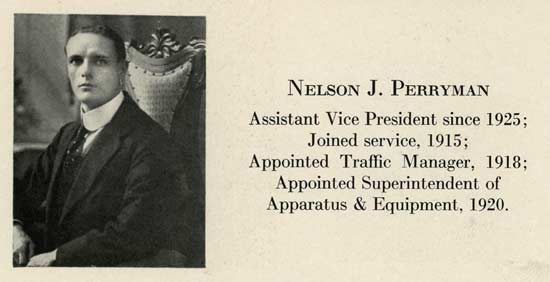
From A Half Century of Cable Service to the Three Americas, All America Cables, Inc., 1928, section listing officers of the company.
This photograph was first published in the All America Review, December 1923, as part of an article on the Home Office in New York City. Perryman was reported as being Superintendent of Apparatus & Equipment at the time. |
Born in 1888 in Halifax, Nova Scotia, of English parents, who soon returned home to England, he grew up in Portsmouth in impoverished circumstances. At 14 he was indentured for 6 years as an apprentice engine fitter at Portsmouth Dockyard where he learned machine work related to the erection and repair of engines and other machinery. In 1907, while still engaged in this work, he entered competitions for a Whitworth Scholarship and a Royal Exhibition (Science). He won both, placed second out of 140 competitors for the Whitworth, but was not permitted to take both and chose the Whitworth, which took him to the City and Guilds (Engineering) College, the Imperial College of Science and Technology of the London University (now the Imperial College of London). In 1910, he graduated second in his class, taking a diploma (ACGI) in electrical engineering.
In May 1910, he was hired by the London firm of Clark, Forde, Taylor & Erskine-Murray, consulting engineers in submarine and wireless telegraphy. Through 1914, he was employed by that firm in preparing details of types for new cables, estimating costs, drawing up contracts, specifications and invitations to tender as well as other work connected with submarine cables, equipment, stations, instruments and electric lighting plant. He was also inspecting engineer on works and cable ships during the manufacture, testing, laying and final testing of submarine cables as well as their removal and repair in both shallow and deep water. At some point prior to his hiring he had learned (probably taught himself) celestial navigation, and he took his sextant to sea to make observations on behalf of his firm, checking the ship’s calculations of latitude and longitude.
His first experience as inspecting engineer on a cable ship was in 1910 when, on October 15th, he went around to Liverpool Street, got a taxi to East India Dock and went aboard the C.S. Telconia bound out to assist the C.S. Colonia in laying the east end of the Bay Roberts, Newfoundland to Penzance cable. He took “after shipment” tests of the cable and then went off to get the rest of his gear, returning about midnight to get some sleep aboard. Next morning they cast off and headed down the Thames, but the ship was short a crewman and a launch was put off to find a man. At Gravesend they let down the anchor and a second launch was put out, and this time a man was found, who came aboard with his small kit bag of gear and straw mattress. The anchor was hoisted and they rounded Broadstairs and Ramsgate and headed west through the English Channel towards Land’s End. It was dirty weather by the time they sighted Lizard’s Head, and they had to put in at Penzance to wait it out before finally getting around to Sennen Cove to run the cable ashore.
This completed, on October 28th they steamed west into the North Atlantic. At about 220 miles off Land’s End and in the dead of night on October 31st, they sent down the grapnel to find old cable, but the sea was uneasy, the wind rising, and in a few hours Captain Hood stopped the work and ordered the crew to lash all down. As they finished, the seas were coming over the bow and washing the decks, and soon the ship was rolling and pitching in a full November gale. For three days they took a battering and were driven a hundred miles further out, the storm smashing a window of the wind screen, snapping the back stay of the forward mast and breaking short the three cast iron legs of the garden seat on the starboard side and washing it back to the stern rail. It was his first time at sea, other than as a child returning with his family to England from Halifax. His stomach was uneasy, and he lost his breakfast while taking a bath. But he was in no way dismayed or deterred. Over the next twenty years, he would spend a large portion of his life aboard ships.
In 1911 he was apparently inspecting engineer for his company on the C.S. Stephan laying cable for the German South American Telegraph Company from Pernambuco, Brazil to Monrovia, Liberia. It appears he taught himself German for this and other work he did in Germany.
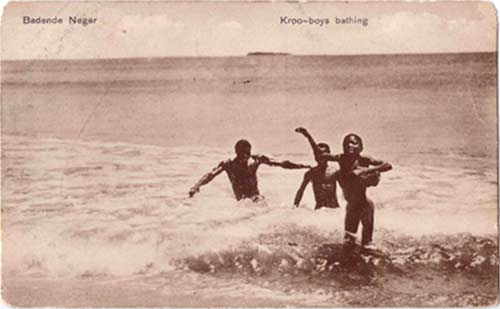
Image from postcard sent by Nelson Perryman from
Monrovia,
Liberia on 1 February 1911 to his future wife in England |
In 1912, he was among a team of inspecting engineers for the Pacific Cable Board on the C.S. Silvertown for the Australia - New Zealand Cable Expedition. They landed cable at Bondi Beach, 16 November 1912 and, according to The Mercury of Hobart, Tasmania, completed the lay at Muriwai Bay on 25 November 1912, the cable pulled onto the black sand beach by 30 bullocks. When the work was finished, he transferred to the Royal Mail Ship Ionic in Wellington and sailed for home via Cape Horn, stopping in Montevideo and Tenerife and arriving in London on 3 March 2013. He was 24 years old and had just circumnavigated the globe.

Handwritten sports program from the papers of Nelson Perryman. The longitude and latitude almost certainly the result of his own celestial navigation using the sextant he carried with him at sea. |
In 1913, he was probably inspecting engineer on the C.S. Dacia for a repair of a cable break off Ballinskelligs, Ireland for the Direct United States Cable Company, a break about 370 cable miles out and in a depth of at least 2300 fathoms (about 2.6 miles down). The same year, he prepared stock cable reports for and he appears to have been inspecting engineer overseeing the manufacture of cable by Norddeutsche Seekabelwerke in Germany and the loading thereof on the C.S. Stephan; it is possible, though there is no direct evidence, he also oversaw the laying of that cable between Balboa, Panama and Santa Elena, Ecuador for the Central and South American Telegraph Company.
In 1915, he left Clark, Forde and Taylor to accept the position of Assistant Electrician and Engineer with the Central and South American Telegraph Company. In January, he married and twelve days later sailed for New York to begin his new career and life in the Americas.
From 1915 through the end of 1919, he was stationed at Lima, Peru. In 1917, in the Miraflores District, his wife gave birth to twins, but, sadly, one child died at birth. It is unclear what sea work he did during this time in Peru. In the June 1924 issue of the All America Review, J.S. Whaley indicates that during the two years he served on the C.S. Guardian as Wireless and Assist (apparently sometime between 1916 and 1920), Mr. Perryman was aboard the ship during various cable repair excursions. Mr. Whaley indicates Mr. Perryman was something of a mentor. In his later years, Mr. Perryman recalled cable repair work he’d done in the estuary of the Esmeraldas River in Ecuador; this may have been during one of the repair excursions of the Guardian. He was also involved in land work, including the installation of an underground conduit system between the Barranco Office and Chorrilles Hut, work that commenced 4 December 1916 and was completed 21 March 1917 and involved the use of a mule and a cart, the acquisition expense of which, together with the mule’s feeding, figured in the cost of the project as he meticulously accounted in his report to New York.
In 1918 he was appointed Traffic Manager, and in April of that year he, together with Joseph Dearlove of London, and Alexander Davidson of Lima, Peru, received British Patents 114,467 and 114,495 for two separate inventions “to provide a means for dividing up a signal consisting of a number of dots or dashes received as a signal or block signal or semi-blocked signal at one end of a submarine cable or other telegraph line into its constituent dots or dashes as transmitted from the sending end of the line, such a method being referred to as interpolation.”
In 1920, the Central and South American Telegraph Company became All America Cables. At the end of the previous year, he, with his wife and child, had sailed to England, where he apparently settled them near or perhaps with relatives, before going away once again on submarine cable work. On May 23rd he left London on the C.S. Faraday to oversee the cable laying from Colon, Panama to Cartagena, Columbia and San Elena, Ecuador to Chorillos, Peru. He then traveled to the east coast, apparently to oversee some or all of the cables laid by the C.S. Colonia between Atalya, Argentina to Rio de Janeiro, Brazil and Montevideo, Uruguay to Santos, Brazil or, perhaps, cables laid by a chartered local vessel, Carceres, from Atalya to Montevideo across the River Plate. In October 1920, he sailed from Buenos Aires, Argentina back to England, and in December the family sailed to New York to establish a new home in Montclair and later Upper Montclair, New Jersey, he having been transferred to All America Cables’ offices in New York City.
In February 1921 he was appointed Superintendent of Apparatus & Equipment. That same year he wrote an article on cable transmitters, beginning in the April issue of All America Review, continuing for several issues, and concluding in September. He also lectured on submarine cables at Yale University. In 1922, he sent a circular letter that resulted in many of the staff of All America Cables enrolling in a technical course conducted by the American School of Correspondence; he received monthly statements on the work done by each student.
In May 1923, he had left on furlough with his family and returned to England where his wife gave birth to twins, both of whom survived. At the end of July, he returned to New York, and on 10 November 1923, he left New York on the Pastores and traveled to Central and South America. He was in Balboa, Panama in December 1923 and apparently was based or remained there, or in Colon, through February 1924. He was in Lima, Peru in March 1924. In April 1924, he was in Arica and Iquique, Chile and perhaps in Bolivia, and, late in May, he was back in Iquique, from which he sailed to New York aboard the SS Teno. According to A Half Century of Cable Service to the Three Americas, published by All America Cables, Inc. in 1928, the company completed a cable between Arica and Iquique, Chile and purchased landline from Arica to La Paz, Bolivia in the 1920s; some of his work in 1924 may have been overseeing this cable laying and purchase.
On September 10, 1924, he left New York and returned to England on the Mauretania. There he apparently oversaw the manufacture of the cable before boarding the C.S. Colonia and returning across the Atlantic to lay a triplicate from New York to Fisherman’s Point, Cuba, to Colon, Panama. By December 1924, he had again returned to England, and the family sailed for New York.
In November 1924, he was issued (as assignor to All America Cables) U.S. Patent 1,735,473 for his invention “to permit the re-transmission of cable signals of definite predetermined characteristics in response to received impulses in which those characteristics may have become more or less obscure.”
In 1925 he was appointed Assistant Vice President of the company.
In May 1926, he went overland on cable business to Mexico City through Laredo, Texas, returning through the same border crossing to New York in June. All America Cables sold a 60 percent ownership interest in the Mexican Telegraph Company that year; the trip presumably was related to the sale. His Spanish, learned while in Peru, would doubtless have proved helpful. It is worth noting that the Cristero War in Mexico had begun that year, and in January a passenger train from Guadalajara to Mexico City had been stopped and many of those on board shot and killed by revolutionaries.
In December 1926, he was once again on cable business via Key West to Havana, returning to New York from Cristobal, Panama in February 1927, having been the company’s representative aboard the C. S. Colonia laying new cables from Fisherman’s Point, Cuba to Port-au-Prince across the Windward Passage. He had his Christmas dinner at Fisherman’s Point, Guantanamo Bay, with Captain Taylor.
In that year, 1927, All America Cables became associated with ITT.
In 1930, he supervised in England the manufacture, and in Venezuela, Columbia and the Canal Zone the laying of submarine cables. In May, he, with his family, had sailed again to England where he had settled them in the home of his sister before going away to undertake the work, which took him aboard the C.S. Dominia to oversee the cable laying from Willemstad, Curacao, Dutch West Indies to La Guayra, Venezuela, from Willemstad to Aruba, from Aruba to Maracaibo, Venezuela, and from Maracaibo to Barranquilla, Columbia.
In early November of 1930, he sailed from Curacao to New York, and in late November, he drove in his new car down to the docks to meet his family returning from England on the SS Adriatic.
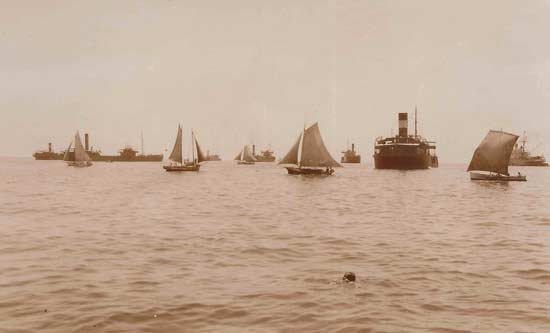
Maracaibo, Venezuela postcards from Nelson Perryman's papers |
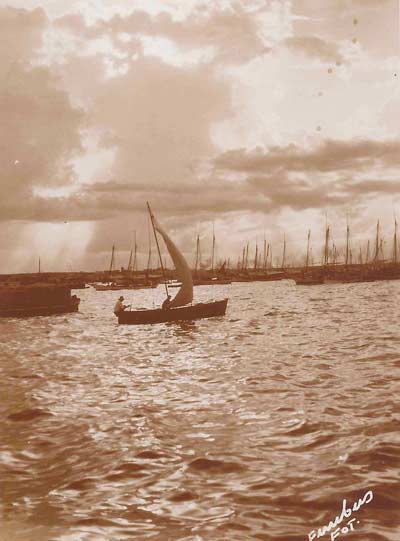 |
This appears to mark the end of his days at sea. It had been a remarkable 20 years: he had crossed the Atlantic at least 16 times; crossed the Pacific; sailed from latitudes above 50 North and to below 50 South; sailed around much, if not all, of South America; laid cable ashore in Europe, Africa, North America, Central America, the Caribbean, South America, Australia and New Zealand; sailed around the Cape of Good Hope and Cape Horn; and, of course, early in his career, setting out from England in 1912 at the age of 23, circumnavigated the globe.
In 1932, he lost his wife, who passed away at the young age of 40. He would not marry again. Until his retirement in 1950, he appears not to have traveled, working entirely in the corporate offices at 67 Broad Street, New York City.
On June 25, 1937, he became a U.S. citizen.
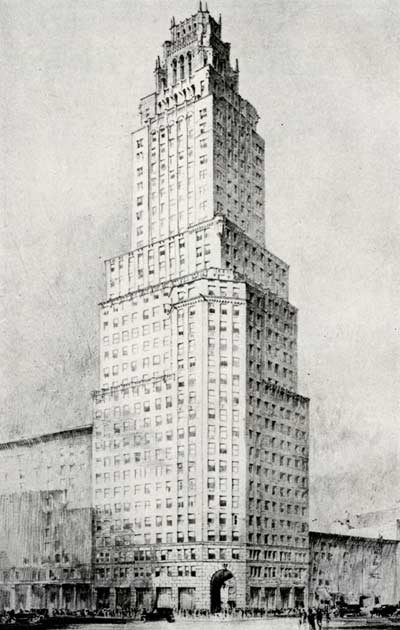
New Home of All America Cables
International Telephone Building
67 Broad Street, New York City
From A Half Century of Cable Service to the Three Americas, All America Cables, Inc., 1928 |
In 1938, the company became All America Cables and Radio, one part of a conglomerate, American Cable and Radio Corporation, held mainly by ITT.
Upon his retirement in 1950, he left New Jersey and moved to a farm in Maine where he lived with his daughter and her husband and their family, helped with farm work, cultivated vegetable and flower gardens, took active and important roles in various aspects of town government affairs, and enjoyed a quiet country life until his passing after a brief illness at the age of 90 in 1979.
I grew up on that farm and remember some of the stories he told of his times at sea, but he was not one to tell many stories. He had an interesting past, but he was living contentedly in the present and was always about his current business with the sort of calm and methodical dedication, good humor, settled competence and keen intelligence that had taken him from an impoverished boy indentured at Portsmouth Dockyard to his remarkable life traveling the world and trotting up the career ladder to become, by the age of thirty-seven, Assistant Vice President of All America Cables.
But I remember his spending long hours among his zinnias and bachelor buttons, sitting on a wooden stool in the sun patiently pulling weeds. I remember him working at the table under the light, carefully piecing together large, complex picture puzzles. I remember him helping me with my school math. He liked to tell elephant jokes, and he laughed at them, freely. He used to sit with us on the living room couch, cheering in a gentlemanly way the Green Bay Packers on the black-and-white TV. And in those long years of his retirement, he learned to paint, became a member of and spent many hours with a local art club. The sea often figured in his sketches and paintings, the sea that ran against the rocky shores of the coast a few miles from our farm and stretched out from there, back to England and all around the world.

